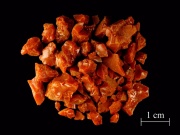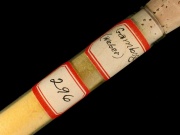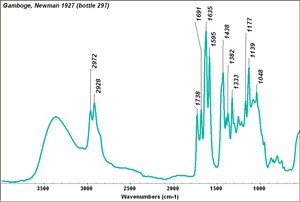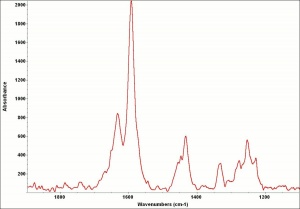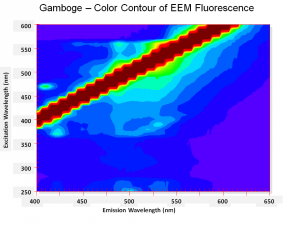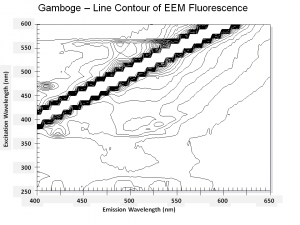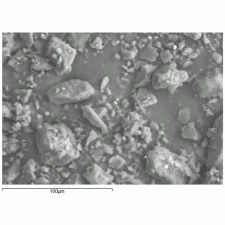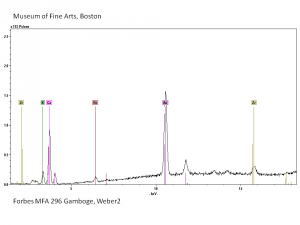Gamboge
Description
A yellow-orange gum-resin produced by several species of Garcinia tree found in India, Thailand, Cambodia, Vietnam, and Ceylon. Gamboge was used as a yellow pigment as early as the 8th century in Asia and Japan. It was regularly imported to Europe in the 17th century but a few earlier deliveries may have occurred. Gamboge is composed of a yellow resinous component (70-80%; morelloflavone) and a clear water-soluble Gum (20%). Gamboge is marketed in the form of dull, brownish-yellow cakes or lumps. When powdered, it has a rich golden color. Gamboge is used as a transparent colorant in dyes, glazes, varnishes, and watercolors. The carbohydrate gum acts as a natural binder. The yellow color fades when exposed to light or Ozone. In some cases it has recovered its color when placed in the dark.
- See also [Uemera Dye Archive (Touou/Kusashio)]
Synonyms and Related Terms
Garcinia sp.; Natural Yellow 24; gomaguta (Esp., Port.); Gummigutt (Deut.); gomme-gutte (Fr.); gomma gutta (It.); giallo Cambogia (It.); gamboji (Jap.); shio (Jap.); kiyo (Jap.); gamboge (Ned., Port.); camboge; cambogia; gum gutta; gutto gumbo; guti ambar; gambogium; rattan yellow; wisteria yellow; gummi-gutti; Siam gamboge; Ceylon gamboge; gokatu gamboge
Risks
- Discolors to red with ammonia and other alkali.
- Fades in sunlight or ozone.
- Toxic by ingestion.
Physical and Chemical Properties
- Yellow resinous portion is soluble in ethanol.
- Colorless carbohydrate portion is soluble in water.
- Burns with an odor of resin.
- Turns red in dilute alkali solutions.
- The small amorphous particles are transparent in transmitted light.
- ISO R105 Lightfastness Classification = 2-3
- Density = 1.2
- Refractive Index = 1.582-1.586
Additional Images
Resources and Citations
- J.Winter, "Gamboge", Artists Pigments, Volume 3, E. West FitzHugh (ed.), Oxford University Press: Oxford, 1997.
- Encyclopedia Britannica, http://www.britannica.com 'Gamboge' Accessed: June 1, 2003
- The Dictionary of Art, Grove's Dictionaries Inc., New York, 1996 Comment: 'Pigments'
- R. J. Gettens, G.L. Stout, Painting Materials, A Short Encyclopaedia, Dover Publications, New York, 1966
- Ralph Mayer, A Dictionary of Art Terms and Techniques, Harper and Row Publishers, New York, 1969 (also 1945 printing)
- M. Doerner, The Materials of the Artist, Harcourt, Brace & Co., 1934
- R.D. Harley, Artists' Pigments c. 1600-1835, Butterworth Scientific, London, 1982
- F. Crace-Calvert, Dyeing and Calico Printing, Palmer & Howe, London, 1876
- Helmut Schweppe, Schweppe color collection index and information book
- Book and Paper Group, Paper Conservation Catalog, AIC, 1984, 1989
- R.Feller, M.Curran, C.Bailie, 'Identification of Traditional Organic Colorants Employed in Japanese Prints and Determination of their Rates of Fading', Japanese Woodblock Prints, Allen Memorial Art Museum, Oberlin College, Oberlin, 1984
- "Violin Varnish Glossary" at www.violins.on.ca/luthier.vargloss.html
- CRC Handbook of Chemistry and Physics, Robert Weast (ed.), CRC Press, Boca Raton, Florida, v. 61, 1980 Comment: density=1.2
- Art and Architecture Thesaurus Online, http://www.getty.edu/research/tools/vocabulary/aat/, J. Paul Getty Trust, Los Angeles, 2000
